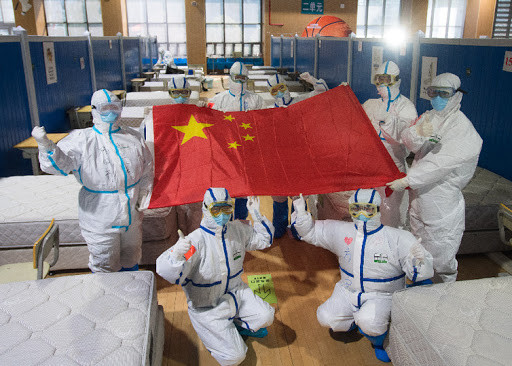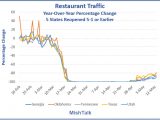
The COVID-19 Chronicles: China
May 16, 2020Author's note: This is part of The Covid-19 Chronicles Series covering how nations and regions are responding to the Coronavirus Disease 2019 (Covid-19) crisis.
May 14, 2020 (Gunnar Ulson - NEO) - With the US spiraling downward, a downward trajectory merely steepened by the Coronavirus Disease 2019 (Covid-19) outbreak, we'd expect other nations to suffer likewise.
But China, where we are told the virus first appeared, has already bounced back. While it has significant damage to repair socioeconomically, it has not only overcome the initial outbreak, but has put into place more resilient measures and means to weather future outbreaks.
Health Impact
China, with a population of nearly 1.4 billion, allegedly suffered between 4,000 and 5,000 deaths from Covid-19.
Just how China, with a population as large as the US plus an extra billion, has so many fewer deaths can be explained several ways.
Some cite quick action taken by the Chinese government to contain the spread of Covid-19. But since Covid-19 clearly spread globally and likely all across China as well, another explanation is much more likely.
A Global Times article titled, "Data methods show gap between US, Chinese flu-related deaths," would note the differences between US and Chinese methods of attributing deaths to the common flu, stating:
Clearly, for those who took the time to look into the underlying health issues many who succumbed to Covid-19 had in the US, they would have found a wide variety of preexisting conditions ranging from morbid obesity, diabetes, heart disease, advanced age and even cancer that Covid-19 simply helped push over the edge.
Counting any and all deaths where Covid-19 was simply present as a "Covid-19 death" is inaccurate and borders on dishonest. As previously reported, many millions more in the US appear to have been infected by Covid-19 than is officially admitted with most people easily overcoming the pathogen.
China appears to have only counted cases where Covid-19 was a primary factor in death, rather than simply contributing to a cocktail of preexisting, chronic health conditions. Because of China's more moderate approach to defining Covid-19's deadliness, it was able to apply more moderate measures to respond.
Measures
Yes, China did initially crackdown heavily on cities where Covid-19 was present, locking down populations and paralyzing travel. Factories were shuttered and supply chains around the globe were impacted.
But it appears that as quick as these lockdowns were implemented, they were lifted and populations across China allowed back to work.
While US car manufacturer Tesla wages a legal and public battle against the government of California to reopen its car plant in Alameda County, Tesla's factory in Shanghai has been reopened for months now.
China is moving forward with caution, but not to the extent of paralyzing society or seizing up economic progress. The largest hurdle China's government will need to overcome is convincing other nations it does business with to return to work and reopen their borders.
Socioeconomic Impact
Because China depends on international trade as well as internal socioeconomic stability to sustain itself, no matter how quickly China itself bounced back from the Covid-19 crisis, the fact that the rest of the world (constituting China's export markets) is lagging behind with some nations like the United States seemingly collapsing before our eyes, means that China itself will suffer to some extent as well.
Closed borders and restrictions on travel have already complicated China's One Belt, One Road (OBOR) initiative. As others have pointed out, this presents both challenges and opportunities, with China able to leverage existing networks to move medical assistance abroad as part of a sort of "Healthcare Silk Road."
For China itself, it is a large and dynamic society with a likewise large and dynamic economy.
As Chinese President Xi Jinping in 2018 once famously said:
Geopolitically, China faces backlash in the form of US propaganda aimed at scapegoating the nation for America's own shortcomings both in the form of its self-inflicted lack of preparations for any sort of healthcare crisis and for its already downturned economy taking yet another hit.
The US appears to be using this scapegoating to further advance its agenda of isolating and undermining China upon the global stage as well as redirecting public ire at home abroad against Beijing rather than at those in Washington chiefly responsible for America's growing crisis.
Covid-19, whatever it actually is, be it a genuinely dangerous pathogen or a dangerous exercise in stoking and exploiting public panic, will define all nations depending on how they weather the crisis and how they bounce back from it.
China appears to have already bounced back and is fully prepared to weather future outbreaks, be they pathogens or in the form of propaganda. For China's competitors, it is clear that tricks are no substitute for actual economic and geopolitical mettle. Those relying on tricks will find themselves swept away by crises like Covid-19, while those relying on economic and geopolitical mettle will prevail.
Gunnar Ulson, a New York-based geopolitical analyst and writer especially for the online magazine “New Eastern Outlook”.
May 14, 2020 (Gunnar Ulson - NEO) - With the US spiraling downward, a downward trajectory merely steepened by the Coronavirus Disease 2019 (Covid-19) outbreak, we'd expect other nations to suffer likewise.
But China, where we are told the virus first appeared, has already bounced back. While it has significant damage to repair socioeconomically, it has not only overcome the initial outbreak, but has put into place more resilient measures and means to weather future outbreaks.
Health Impact
China, with a population of nearly 1.4 billion, allegedly suffered between 4,000 and 5,000 deaths from Covid-19.
Just how China, with a population as large as the US plus an extra billion, has so many fewer deaths can be explained several ways.
Some cite quick action taken by the Chinese government to contain the spread of Covid-19. But since Covid-19 clearly spread globally and likely all across China as well, another explanation is much more likely.
A Global Times article titled, "Data methods show gap between US, Chinese flu-related deaths," would note the differences between US and Chinese methods of attributing deaths to the common flu, stating:
"The US flu mortality rate includes cases where flu causes other illnesses to worsen and lead to death, while China only counts people who die directly from flu," an observer who prefers to be anonymous told the Global Times.A similar approach was most likely used to tally Covid-19 deaths.
Clearly, for those who took the time to look into the underlying health issues many who succumbed to Covid-19 had in the US, they would have found a wide variety of preexisting conditions ranging from morbid obesity, diabetes, heart disease, advanced age and even cancer that Covid-19 simply helped push over the edge.
Counting any and all deaths where Covid-19 was simply present as a "Covid-19 death" is inaccurate and borders on dishonest. As previously reported, many millions more in the US appear to have been infected by Covid-19 than is officially admitted with most people easily overcoming the pathogen.
China appears to have only counted cases where Covid-19 was a primary factor in death, rather than simply contributing to a cocktail of preexisting, chronic health conditions. Because of China's more moderate approach to defining Covid-19's deadliness, it was able to apply more moderate measures to respond.
Measures
Yes, China did initially crackdown heavily on cities where Covid-19 was present, locking down populations and paralyzing travel. Factories were shuttered and supply chains around the globe were impacted.
But it appears that as quick as these lockdowns were implemented, they were lifted and populations across China allowed back to work.
While US car manufacturer Tesla wages a legal and public battle against the government of California to reopen its car plant in Alameda County, Tesla's factory in Shanghai has been reopened for months now.
China is moving forward with caution, but not to the extent of paralyzing society or seizing up economic progress. The largest hurdle China's government will need to overcome is convincing other nations it does business with to return to work and reopen their borders.
Socioeconomic Impact
Because China depends on international trade as well as internal socioeconomic stability to sustain itself, no matter how quickly China itself bounced back from the Covid-19 crisis, the fact that the rest of the world (constituting China's export markets) is lagging behind with some nations like the United States seemingly collapsing before our eyes, means that China itself will suffer to some extent as well.
Closed borders and restrictions on travel have already complicated China's One Belt, One Road (OBOR) initiative. As others have pointed out, this presents both challenges and opportunities, with China able to leverage existing networks to move medical assistance abroad as part of a sort of "Healthcare Silk Road."
For China itself, it is a large and dynamic society with a likewise large and dynamic economy.
As Chinese President Xi Jinping in 2018 once famously said:
The Chinese economy is a sea, not a pond. Storms can overturn a pond, but never a sea.Judging by how quickly China has gone back to business with the most significant damage being incurred simply by China waiting for its trade partners to likewise bounce back, this is just as true today as it was when President Xi said it two years ago.
Geopolitically, China faces backlash in the form of US propaganda aimed at scapegoating the nation for America's own shortcomings both in the form of its self-inflicted lack of preparations for any sort of healthcare crisis and for its already downturned economy taking yet another hit.
The US appears to be using this scapegoating to further advance its agenda of isolating and undermining China upon the global stage as well as redirecting public ire at home abroad against Beijing rather than at those in Washington chiefly responsible for America's growing crisis.
Covid-19, whatever it actually is, be it a genuinely dangerous pathogen or a dangerous exercise in stoking and exploiting public panic, will define all nations depending on how they weather the crisis and how they bounce back from it.
China appears to have already bounced back and is fully prepared to weather future outbreaks, be they pathogens or in the form of propaganda. For China's competitors, it is clear that tricks are no substitute for actual economic and geopolitical mettle. Those relying on tricks will find themselves swept away by crises like Covid-19, while those relying on economic and geopolitical mettle will prevail.
Gunnar Ulson, a New York-based geopolitical analyst and writer especially for the online magazine “New Eastern Outlook”.


